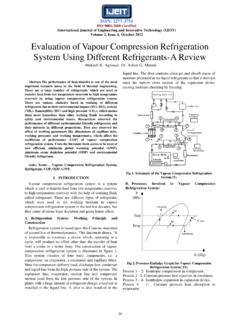Transcription of SlurryICE TM THERMAL ENERGY STORAGE DESIGN GUIDE
1 SlurryICE TM. THERMAL ENERGY STORAGE . DESIGN GUIDE . ENVIRONMENTAL PROCESS SYSTEMS LIMITED. SLURRY-ICE APPLICATION GUIDE . 10 INTRODUCTION. History of refrigeration Alternatives CURRENT ICE PRODUCTION TECHNOLOGIES. - Static Ice Production Systems - Dynamic Ice Production Systems 3 .0 SLURRY ICE TECHNOLOGY. GENERATOR TYPES. SLURRY ICE CHARACTERISTICS. Slurry ice Cooling Capacity Slurry ice Types Slurry ice Behaviour Pipes - Variation of Pressure gradient with Ice Fraction Heat Transfer Co-efficient with Ice Fraction. Pumps Fittings and Valves SLURRY ICE DISTRIBUTION. Pipeline Transport of Slurry ice Slurry ice Vessel Pipe Network Mechanical Conveyor System Operating Strategy Constant Flow / Variable Ice Fraction (Strategy 1): Purge and Stop (Strategy 2): Slurry Ice/Water Mixing Pumping (Strategy 3): Mechanical Removal System (Strategy 4): SLURRY-ICE BASED COOLING SYSTEMS APPLICATION GUIDE 2.
2 ENVIRONMENTAL PROCESS SYSTEMS LIMITED. SLURRY ICE STORAGE . ICE STORAGE SYSTEMS. Distributed STORAGE Central STORAGE Dry Ice STORAGE SLURRY ICE STORAGE SIZING. refrigeration Capacity Ice STORAGE Capacity SLURRY ICE STORAGE TANK DESIGN . Free Liquid STORAGE Tank DESIGN Flooded STORAGE Tank DESIGN Harvester Tank DESIGN ADDITIONAL DESIGN CONSIDERATIONS. 6. 0 RECOVERING STORED COOLING. Mechanical Technique Passive Technique Operating Strategy for Central STORAGE SLURRY ICE UTILISATION. Direct Slurry ice Concept Reduced Heat Transfer Co-Efficiency Increased Temperature Difference Slurry ice Blockage New Heat Exchanger DESIGN Distributed Ice STORAGE Concept Warm Water Recycle Concept Slurry-Ice Supply/Return Heat Exchange Concept CONTROLS.
3 Control Valves Control for Central STORAGE Tanks Controls for Slurry Delivery SLURRY-ICE BASED COOLING SYSTEMS APPLICATION GUIDE 3. ENVIRONMENTAL PROCESS SYSTEMS LIMITED. 1 - INTRODUCTION. History of refrigeration Jacob Perkins, an American living in London, patented the first closed vapour compression refrigeration system, receiving British Patent 6662 dated 1884. Ethylether was utilised as the refrigerant. Refrigerant grade Ammonia production began in the period 1876 to 1879 by the Company and widely used in industry, along side Sulphur dioxide and Methyl Chloride as alternatives. In the early years of refrigeration the available refrigerants were less than satisfactory, being either flammable, toxic or both.
4 The risks involved using the early refrigerants directly were high and therefore various secondary cooling brines so called Secondary Refrigerants are utilised to cool product and process indirectly. In 1928, Thomas Midgley introduced a small quantity of R21 and demonstrated that it was of low acute toxicity and non-flammable refrigerant. What followed was a very methodical evaluation of a large number of chlorofluorocarbons, culminating in the dramatic introduction of R12 (CFC) at a meeting of the American Chemical Society in 1930. This was the beginning of the modern refrigerants as we know them today.
5 In 1974, S. Rowland and M. Molina developed a CFC/ozone hypothesis in which chlorofluorocarbons (CFCs), along with other gases, were accused of harming the earth's atmosphere by two phenomena described as: The Greenhouse Theory, which states that chemicals known as "Greenhouse Gases" absorb infra-red radiation, intercepting it leaving the earth's atmosphere and resulting in climate warming. The Ozone Depletion Theory, which states that certain gases accumulating in the upper atmosphere will, through a complicated series of chemical reactions, catalyse the destruction of ozone and thus upset the balance of its continuous creation and destruction.
6 The severity of any potential regulations and the speed with which they are implemented can depend heavily on public pressure and the realisation of the extent of damage which was under-estimated during early studies in the mid 1970's. The latest scientific evidence forced politicians to re-consider the restrictions in of CFCs 1987 with the Montreal Protocol and later in 1992 with the Copenhagen Agreement, which shortened the phase out dates. Alternatives Society's reliance on vapour compression cooling technology ranges from critical medical applications, to providing a cool beverage or a child's ice cream treat on a sunny day.
7 As a result, modern air conditioning and refrigeration technologies together with a wide range in food processing and preservations infra-structures have evolved around wide spread production of the vapour compression cycle. Furthermore, emergence of CFC and HCFC working fluids since the 1930's provided fresh impetus to already existing technology and gave rise to an ever expanding spread from the basic applications. Figure: shows current alternative refrigerants nevertheless the structure of the alternative refrigerants still remains as the eight basic elements identified by Thomas Migley's team in the early 20th century.
8 A L T E R NA TIV E R E F R IG E R A N T S. T R A N S IT IO N A L M E D IU M & L O N G T E R M. R E F R IG E R A N T S R E F R IG E R A N T S. HCFC HFC HALOG EN. (Chlorinated) (Chlorine Free) FREE. SINGLE SUBSTANCE BLENDS SINGLE SUBSTANCE BLENDS SINGLE SUBSTANCE BLENDS. R 22 R 22 R 134a R 143a/125/134a R 290 R 290 B ased R 124 BASED R 125 R 143a/125 R 600a R 600a B ased R 123 R 32 R 32-B A SE D R 717. R 152a R 143a R 729. R 744. L i-B r/W ater N H 3/W ater Figure : Current Alternative Refrigerant Options SLURRY-ICE BASED COOLING SYSTEMS APPLICATION GUIDE 4. ENVIRONMENTAL PROCESS SYSTEMS LIMITED. It is vital to establish a balance between " ENERGY consumption" and "environment protection".
9 Any change in refrigeration technology by means of introducing new refrigerants or by adopting new techniques must be carefully balanced to reduce the overall environmental impact. Therefore a method of calculation (TEWI) has been developed in which the influence upon the Greenhouse Effect (Global Warming Impact) can be judged for the operation of individual refrigeration plants. Direct or indirect ice usages has also expanded over the years to reduce operational costs and improve system control. Dynamic or Static ice production methods have been developed for various applications. Environmental concerns over the ozone depletion potential of some CFCs used today have prompted a search for alternative cooling technologies.
10 Slurry ice has the potential to achieve considerable environmental as well as economic benefits for both central cooling systems and direct ice production for ever expanding ice applications. Any of the alternative primary refrigerants can be used for slurry ice production, The cooling capacity of slurry ice can be four to six times higher than that of conventional chilled water, depending on the ice fraction . The nature of the Binary (Crystal) ice formation allows end users to pump the ice, providing easy handling and intimate contact with the product, for higher chilling efficiencies. There are many slurry ice-based cooling systems operating around the world.



